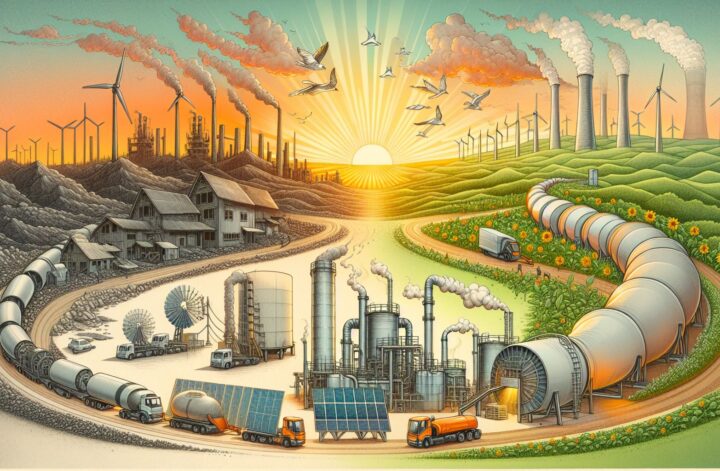In the present age when the threats of global warming and environmental degradation loom large, the efficient utilization of renewable energy is crucial in paving the way towards sustainability. One of the major players in this aspect is biogas, a renewable form of energy that’s produced through the breakdown of organic material. However, this process of production and the subsequent upgrading of biogas isn’t as mainstream knowledge as, say, solar, and hence needs more highlighting and understanding. In this article, we delve into the process, benefits, future prospects, and challenges of biogas production and biogas upgrading.
Biogas Production
Biogas production occurs in a process known as anaerobic digestion. The term ‘anaerobic’ means without oxygen, and ‘digestion’ refers to the breakdown of organic matter [1]. This process involves a series of stages like hydrolysis, acidogenesis, acetogenesis, and methanogenesis, all of which take place in an anaerobic digester.
In hydrolysis, the complex organic molecules are broken down into simple sugars, amino acids, and fatty acids. Acidogenesis then produces volatile fatty acids and alcohols. During acetogenesis, these substances are converted into hydrogen, carbon dioxide, and acetic acid. Finally, methanogenesis occurs, where methanogens organisms convert these products into methane and water. The result of this process is biogas, primarily composed of methane (CH4) and carbon dioxide (CO2), and a by-product known as digestate.
Multiple parameters are involved in controlling and optimizing the process of anaerobic digestion. These include volatile solids reduction, hydraulic retention time (HRT), solid retention time (SRT), and organic loading rate (OLR).
Biogas Upgrading
The biogas produced in the process above is usually in the raw form and contains impurities like hydrogen sulfide, water, particulates, and other trace gases. Upgrading of biogas thus involves the treatment and removal of these impurities to increase the quality and usability of biogas [2]. After the upgrading process, biogas becomes biomethane, a renewable natural gas that’s ready for multiple uses.
There are various techniques available for biogas upgrading, including pressure swing adsorption, water scrubbing, chemical scrubbing, and membrane separation. Among them, biogas scrubbing is commonly used to remove carbon dioxide and other impurities from biogas.
The Benefits and Future Prospects
Biogas production and its subsequent upgrading hold tremendous promise for renewable energy and sustainability. They provide a renewable, sustainable, and eco-friendly energy source and help with waste management too. Using organic waste for biogas production not only diverts waste from landfills but also reduces the emission of greenhouse gases.
Biomethane produced from biogas can be used in several ways. It serves as a fuel for vehicles, can be utilized for heating, electricity generation, and can even be injected into the natural gas grid.
The prospects of biogas upgrading look particularly promising. There is increasing interest in the potential of biogas as the ‘green gas’ that could replace natural gas for various applications. The technology for biogas upgrading is also improving, which augurs well for its future efficiency and utilization.
The Challenges
Despite the various benefits and promising prospects, producing and upgrading biogas also pose challenges. Anaerobic digestion is a complex process that requires optimal conditions, and any changes in these can lead to plant instability or process failure. Inhibitions, ammonia toxicity, and sulfide toxicity, are some of the potential hurdles, and overcoming these will be paramount to improving biogas production in future [3].
The upgrading of biogas also has its challenges, primarily operating cost and energy consumption. The future of biogas upgrading would hugely depend on how efficiently we can solve these problems.
Conclusion
In conclusion, biogas production and upgrading provide us with a fantastic opportunity to solve our energy and environmental problems. However, to take full advantage of these possibilities, we need to focus more on research and innovation, and address the existing challenges head-on.
References
-
California Energy Commission. (2008). How is Biogas Produced? [California’s Renewable Energy Program]. Retrieved from website
-
Bauer, F., Persson, T., Hulteberg, C., & Tamm, D. (2013). Biogas upgrading – Review of commercial technologies. Svenskt Gastekniskt Center AB, Malmö. Retrieved from website
-
Siles, J. A., Brekelmans, J., Martín, M. A., Chica, A. F., & Martín-Marroquín, J. M. (2016). Techno-economic analysis of biogas upgrading technologies using a rigorous model. Biosystems Engineering, 146, 71-82. Retrieved from website




